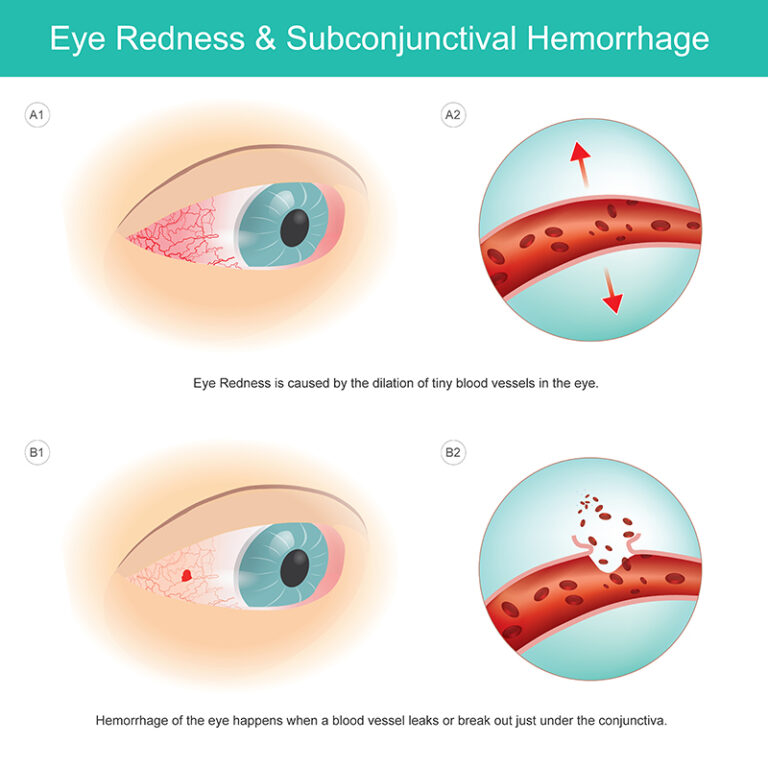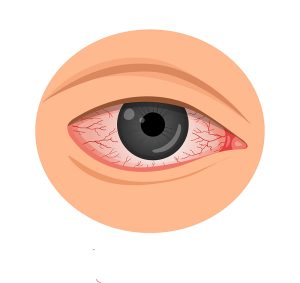
What are red eyes?
Red eyes are a general term for eyes that become red or bloodshot. This eye condition occurs whenever the eye is irritated. Your eyes will begin to turn red due to the enlargement, or dilation, of the blood vessels on the surface of the eye. This condition can affect one or both eyes, and may develop over time or can show up suddenly.
What are the symptoms of red eyes?
The actual term red eyes refers to the bloodshot appearance of the eyes. However it is often accompanied with other eye symptoms. These symptoms may include:
- Eye pain or irritation
- Itching
- Eye Discharge
- Swollen Eyes
- Blurred Vision and/or vision changes
If redness of the eye remains for more than one week or is accompanied by pain or reduction in vision, it is important to have your eyes checked immediately.
What are the causes of red eyes?
There are quite a few conditions that can cause your eyes to look red and/or irritated. One of the most common causes of red eyes is allergies. Allergies can affect only the eyes or can be accompanied by a runny nose, sneezing, and other symptoms. Allergic eyes are generally itchy and stay red for an extended period of time. If you have an allergy affecting your eyes, there are good medications available to treat the symptoms to reduce itching and redness.
Another common cause is Pterygium, or “Surfer’s Eye”. This is a red fleshy growth on the surface of the eye which is caused by ultraviolet light damage over a number of years. Pterygium can cause redness and irritation of the eyes. Another cause of red eyes may be Conjunctivitis, or pinkeye. It is an infection of the surface of the eye that is common in both children and adults. Conjunctivitis is like a cold in the eye and is capable of being passed from one person to another just like a regular cold, often resulting in irritation and red eyes.
Subconjunctival hemorrhage is another common eye condition that may result in red eyes. As we get older, small amounts of bleeding on the surface of the eye may occur. Because a small amount of blood under the clear tissue that covers the eye looks very red, many people are quite frightened by this. However, it is harmless and you know that this is the problem when the eye looks blood red and doesn’t feel or see any differently than usual. These generally heal themselves on their own within one to two weeks. They can come from coughing, straining, or sneezing. If due to an injury, a thorough eye examination must be done to be sure there is no other injury to the eye.
**Other more serious causes of red eyes may include dry eye, glaucoma, and Iritis. Dry eyes occur when the eyes are not producing enough tears or the tears lack lipid, causing the eye to become red and often painful. This can be helped by moistening the eye with artificial tears.
Glaucoma may cause red eyes as well due to increased eye pressure and abnormal blood vessels in the eye. Because glaucoma is a sight-threatening condition and requires immediate medical attention, be aware of suddenly painful, bright-red eyes, along with symptoms such as seeing halos, vision loss, and nausea.
Iritis is an inflammation inside of your eye that can make the eye red, sore, and sensitive to light. This inflammation requires treatment and it is best to see your ophthalmologist if your red eye is accompanied by pain, light sensitivity, or lasts more than a few days. Some infections and inflammations of the eye can be dangerous if left untreated. So if you have a red eye that lasts more than a few days, or if your vision is also blurred or your eye is painful, see your eye specialist as soon as you can.
How will I know if I have it? What are the treatment options?
You will know that you have red eyes by the bloodshot appearance that may be accompanied by eye irritation or other symptoms affecting the eye. However, most of the time a red eye will look worse than it feels, and the case is relatively harmless. Red eyes often go away or improve with home remedies or over the counter medications. Treatment may include recommended or prescribed antibiotics, special eye drops or ointments to clean and disinfect the eyelid. Some home remedies for treating red eyes include placing a warm damp washcloth over the eyes for a few minutes and using a cotton swab dipped in water and baby shampoo to clean the eyelids.
Other recommendations to prevent red eyes from occurring include:
- Getting a full and restful sleep
- Refrain from rubbing the eyes
- Disinfect contact lens after wearing (Do not wear for prolonged periods of time)
- Remove eye makeup before going to sleep and after prolonged wear
- Taking breaks from looking at digital screens
- Maintaining regular eye exams
Remember that although red eyes usually go away on their own or through home remedies and over the counter treatments, prolonged red eyes (Over one week) accompanied by severe eye symptoms may be a sign of a more serious eye condition and requires medical care. If you are experiencing red eyes and symptoms such as eye pain, light sensitivity, swelling, blurry and/or reduced vision, speak to an ophthalmologist at once.



